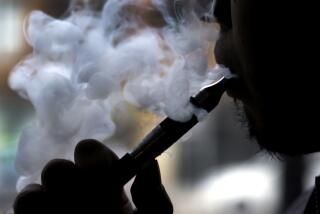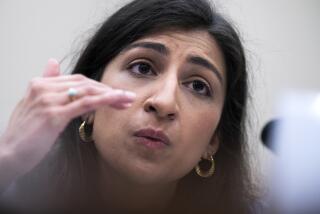FTC Considers Tougher Rules for Tobacco Firms : Regulation: Agency is concerned about some companies’ use of tar, nicotine ratings to justify ‘light’ labels.
- Share via
WASHINGTON — The Federal Trade Commission, seeking to force tobacco companies to disclose more about the potential hazards of smoking, is considering tougher labeling requirements and use of the agency’s enforcement power to punish companies for ads it considers deceptive.
At issue are FTC tar and nicotine ratings that some companies use to justify labeling cigarettes “light.” For years, health experts have said that FTC test machines don’t accurately assess the amount of nicotine and tar that smokers inhale, giving smokers a false impression that “light” cigarettes are less hazardous to their health.
“If you’re talking about smoking cigarettes that are lower in tar, lower in nicotine, there is real data that people do compensate,” Jodie Bernstein, director of the FTC’s consumer protection bureau, said Thursday. “They inhale more, they take more puffs per cigarette, and in fact they smoke more.”
As a result, the FTC staff may make several recommendations to the commission, among them changing the rating system. Another option is suing tobacco companies that the agency finds are using current tar and nicotine ratings to mislead consumers, Bernstein said.
A finding of deceptive advertising could force the industry to revamp its highly successful campaigns for such low-tar brands as Loews Corp.’s True and Philip Morris Cos.’ Merit, as well as provide another boost to regulators and lawyers suing the major cigarette firms.
FTC machines now measure puffs of smoke at only one rate, Bernstein said. The FTC could change the way the machines work, and it could require companies that advertise tar and nicotine levels to report a range, depending on frequency and strength of puffs.
FTC staffers may also recommend that the agency or industry come up with guidelines. The recommendations are expected to be presented to the commission in about two months, Bernstein said. In addition, the FTC has asked the National Cancer Institute to examine its test.
The possibility of stiffer regulations comes as no surprise to tobacco companies.
“This has been discussed or rumored for the past year, but until the FTC comes forward with it, we won’t comment,” said Joe Helewicz, vice president of corporate communications at Brown & Williamson, the U.S. tobacco division of BAT Industries. “We’re dealing with something like jello out there.”
Goldman, Sachs & Co. tobacco analyst Marc I. Cohen played down the potential impact of the latest FTC options. He said the agency would have a tough time showing that companies following FTC guidelines had deceived consumers. Also, he said, labels with nicotine and tar ranges wouldn’t have much consumer impact. “It’s a small issue,” he said.
The Tobacco Institute, an industry trade group, said the current system is useful in helping consumers decide among brands.
“The current system works the way it was supposed to,” institute spokeswoman Brennan Dawson said. She declined comment on the threat of a deceptive-advertising claim or other FTC measures under consideration.
Philip Morris, the world’s largest cigarette company, also declined to comment.
In 1994, the FTC considered charging a tobacco company with deceptive advertising by targeting RJR Nabisco Holdings Corp.’s Joe Camel cartoon character. However, the commission voted 3 to 2 in favor of the company.
The FTC’s move to consider changing the tar and nicotine standards is another step in a process that began in August 1994 when the National Cancer Institute heard testimony on the issue. Then, tobacco companies testified that the current method was adequate.
If the FTC does pursue a false-advertising claim, it will first have to target an individual company, then vote on the charges before filing suit.
More to Read
Inside the business of entertainment
The Wide Shot brings you news, analysis and insights on everything from streaming wars to production — and what it all means for the future.
You may occasionally receive promotional content from the Los Angeles Times.










